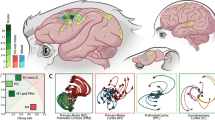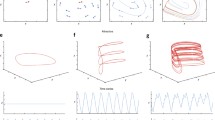Abstract
Understanding the neural computations performed by the motor cortex requires biologically plausible models that account for cell discharge patterns revealed by neurophysiological recordings. In the present study the motor cortical activity underlying movement generation is modeled as the dynamic evolution of a large fully recurrent network of stochastic spiking neurons with noise superimposed on the synaptic transmission. We show that neural representations of the learned movement trajectories can be stored in the connectivity matrix in such a way that, when activated, a particular trajectory evolves in time as a dynamic attractor of the system while individual neurons fire irregularly with large variability in their interspike intervals. Moreover, the encoding of trajectories as attractors ensures high stability of the ensemble dynamics in the presence of synaptic noise. In agreement with neurophysiological findings, the suggested model can provide a wide repertoire of specific motor behaviors, whereas the number of specialized cells and specific connections may be negligibly small if compared with the whole population engaged in trajectory retrieving. To examine the applicability of the model we study quantitatively the relationship between local geometrical and kinematic characteristics of the trajectories generated by the network. The relationship obtained as a result of simulations is close to the ‘2/3 power law’ established by psychophysical and neurophysiological studies.
Similar content being viewed by others
References
Ashe J, Taira M, Smyrnis N, Pellizzer G, Georgakopoulos T, Lurito JT, Georgopoulos AP (1993) Motor cortical activity preceding a memorized movement trajectory with an orthogonal bend. Exp Brain Res 98:118–130
Douglas RJ, Martin KAC, Whitteridge D (1989) A canonical microcurcuit for neocortex. Neural Comput 1:480–488
Georgopoulos AP (1991) Higher order motor control. Annu Rev Neurosci 14:361–377
Georgopoulos AP, Caminiti R, Kalaska JF, Massey JT (1983) Spatial coding of movement: a hypothesis concerning the coding of movement by motor cortical population. Exp Brain Res [Suppl 7]:327–336
Georgopoulos AP, Schwartz AB, Kettner RE (1986) Neuronal population coding of movement direction. Science 233:1416–1419
Georgopoulos AP, Kettner RE, Schwartz AB (1988) Primate motor cortex and free arm movement to visual targets in three-dimensional space. II. Coding of the direction of movement by a neuronal population. J Neurosci 8:2928–2937
Georgopoulos AP, Taira M, Lukashin AV (1993) Cognitive neurophysiology of the motor cortex. Science 260:47–52
Gerstner W, Ritz R, Hemmen JL van (1993a) A biologically motivated and analytically soluble model of collective oscillations in the cortex. I. Theory of weak locking. Biol Cybern 68:363–374
Gerstner W, Ritz R, Hemmen JL van (1993b) Why spikes? Hebbian learning and retrieval of time-resolved excitation patterns. Biol Cybern 69:503–505
Hocherman S, Wise SP (1991) Effects of hand movement path on motor cortical activity in awake, behaving rhesus monkeys. Exp Brain Res 83:285–302
Keller A (1993) Intrinsic synaptic organization of the motor cortex. Cerebral Cortex 3:430–441
Lacquaniti F, Terzuolo C, Viviani P (1983) The law relating the kinematic and figurai aspects of drawing movements. Acta Physiol 54:115–130
Lukashin AV, Georgopoulos AP (1994) A neural network for coding of trajectories by time series of neuronal population vectors. Neural Comput 6:19–28
Lukashin AV, Wilcox GL, Georgopoulos AP (1994) Overlapping neural networks for multiple motor engrams. Proc Natl Acad Sci USA 91:8651–8654
Lukashin AV, Wilcox GL, Georgopoulos AP (1996) Modeling of directional operations in the motor cortex: a noisy network of spiking neurons is trained to generate neural-vector trajectories. Neural Networks, in press
Massey JT, Lurito JT, Pellizzer G, Georgopoulos AP (1992) Three dimensional drawing in isometric conditions: relation between geometry and kinematics. Exp Brain Res 88:685–690
Schwartz AB (1993) Motor cortical activity during drawing movements: population representation during sinusoid tracing. J Neurophysiol 70:28–36
Schwartz AB (1994) Direct cortical representation of drawing. Science 265:540–542
Smyrnis N, Taira M, Ashe J, Georgopoulos AP (1992) Motor cortical activity in a memorized delay task. Exp Brain Res 92:139–151
Softky WR, Koch C (1993) The highly irregular firing of cortical cells is nconsistent with temporal integration of random ESPSs. J Neurosci 13:334–350
Taira M, Georgopoulos AP (1993) Cortical cell types from spike trains. Neurosci Res 17:39–45
Viviani P, Terzuolo CA (1982) Trajectory determines movement dynamics. Neuroscience 7:431–437
Author information
Authors and Affiliations
Rights and permissions
About this article
Cite this article
Lukashin, A.V., Amirikian, B.R., Mozhaev, V.L. et al. Modeling motor cortical operations by an attractor network of stochastic neurons. Biol. Cybern. 74, 255–261 (1996). https://doi.org/10.1007/BF00652226
Received:
Accepted:
Issue Date:
DOI: https://doi.org/10.1007/BF00652226




